
Robin, the Boy Wonder, is one of the most controversial characters in superhero comics. First debuting in 1940 as a transparent attempt to (what else?) attract new readers, he immediately became a popular and enduring staple of the Batman mythos despite inspiring decade’s worth of Gay Panic, humorous or otherwise. The general populous conceives Robin as an eternal twelve year-old, jumping around rooftops when he should be doing his homework. But who can concentrate on algebra when Killer Croc’s out killing mobsters in a bid to take over Gotham City’s underworld? What kid wouldn’t want to live over the Batcave?
Thankfully, comic book Robin’s been allowed to grow up. By the late 70s, his civilian identity, Dick Grayson, had graduated high school and moved off to college. As Robin, he’d assumed command of the Justice League’s youth brigade, the Teen Titans, and helped save the world on numerous occasions. By 1983, he’d all but disappeared from Gotham, necessitating a new youngster fill his little green boots.
Enter Jason “Oh my God” Todd. As in “Oh my God, Bruce, I can not believe you took this kid under your wing.” First conceived as a transparent replacement for Dick Grayson (how transparent? Well, Jason was also a second generation circus acrobat whose parents also happened to catch their death from Crime), Jason suffered a lot in the great continuity rewrite of 1986, Crisis on Infinite Earths. When the multiverse finally stabilized, Jason was reborn as a street urchin, orphaned by Crime and taken in by Batman after Bruce caught him trying to steal tires…off the Batmobile…yeah…

That pretty much sums up everyone’s problem with Jason in an image. No longer a straight Xerox of his predecessor, Jason became a Darker and Edgier version of the Kid Sidekick in general. It was 1980s and DC Comics hoped giving Batman a “modernized” sounding board would (what else?) attract new readers. Problem was, writers began writing their “modern” Robin as a angry, disrespectful, entitled little shit who ignored Batman whenever he felt like it, no matter the trouble it caused. Over the next two years, Jason became all the worst cliches of adolescence in one sidekick-shaped carrying case. That’s why, in 1988, DC decided it was time he died.
Except they didn’t really have the balls to do that outright. The last panel of Batman #427 ended on a cliffhanger, with Jason kidnapped and beaten to a bloody pulp by the Joker; left for dead on the floor of an anonymous warehouse in some Third World hellhole (Ethiopia in the comics, Sarajevo here). Batman arrived on the scene just as a bomb obliterated everything in sight. The last page of the issue directed readers to a 900 number. For fifty cents, fans could input one of two codes, casting their vote for what Batman would find in the wreckage next month. A dead sidekick won over a live one by a margin of 5,343 to 5,271.
For fans of Bronze Age superhero comics, this was a watershed event. Some people even use the story (collectively known as Batman: Death in the Family) to mark the start of the Dark Age in January, 1989 (about three years late, by my Watchmen-loving estimation, but I’m not debating them at the moment). No less an expert on ugly cynicism than Frank Miller himself called it, “the ugliest thing I’ve seen in comics, and the most cynical.” It (along with the upcoming Tim Burton film) certainly drew mainstream eyes toward Batman, generated a lot of pointless press and (yes) even a few new readers.
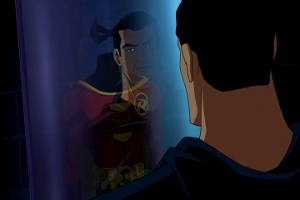
Whether a dramatic paradigm shift or a shameless publicity stunt, Jason’s death cast a long, deep shadow over ’90s Batman comics. Writers eventually grew to treat it as Batman’s second-greatest personal tragedy, right behind his parent’s murder. He even put Jason’s costume under glass in the Cave, a heartfelt memorial to a fallen soldier. It became a reoccurring visual motif in its own right, exploited by every artist worth his or her salt. You couldn’t set a scene in the Batcave without some reference to that glass tube, even if only as a half-obscured shape in the deep background. As Batman editor Denny O’Neil said, “It would be a really sleazy stunt to bring [Jason] back.”
So, in 2005, they did just that. Six years later, here’s the movie. Aren’t you excited? I know I wasn’t. The writer responsible for all this, former realty TV star Judd Winick, said at the time,
“I was less interested in the how and the why and the what of Jason Todd returning from the dead than I am about what Jason’s return will do to Batman. Now.”
The rest of us were perfectly happy with what Jason’s life and death did to Batman in the past. As a Robin, he was never much more than a replacement. As a uniform under glass, he was an object lesson in the price tag attached to a life of masked vigilantism…never mind a life as full of psychopaths as Batman’s. The whole experience taught Bruce random street kids don’t make good sidekicks (unless they’re mute and trained from birth by international master assassins) and it taught Bat-fans that the lighthearted, chummy days of the 1960s were well and truly gone.
As if to hammer this home (heh…see what I did there?) Under the Red Hood The Movie opens with Jason (Vincent Martella)’s death at the hands (and crowbar) of the Joker (John Di Maggio). Batman arrives just in time to dig his sidekick’s body from the wreckage, recreating an iconic image from 1989…with most of the blood removed. Because we wouldn’t want to shock and/or horrify anyone, now, would we? This is a superhero cartoon, after all.

The credits allow time to skip ahead five years. Seems a mysterious someone (Jensen Ackles) has begun killing mobsters in a bid to take over Gotham City’s criminal underworld. This someone‘s assumed the long-established but rarely seen identity of the Red Hood, a nom de guerre utilized by several DC Universe criminals in the past…including the failed stand-up comedian who eventually became the Joker. This new Hood’s not crazy, though: he’s methodical, purposeful, winning underlings over with a line of argument one could easily summarize as “Cake or Death?” Most choose “cake” when confronted with the severed heads of their associates. This makes Red Hood the new Number One Concern of crime boss Black Mask (Wade Williams), “the first boss to unite the city in twenty years.” Loosing soldiers left and right, Black Mask turns to some outside talent. This inevitably fails. So, having never seen The Dark Knight, he makes the biggest mistake any Gotham mob boss could make and breaks the Joker out of Arkham Asylum.
All of which inevitably attracts Batman, who’d already planned to talk to Black Mask about his super-powered android smuggling operation anyway. For some reason, Nightwing (Neil Patrick Harris) shows up at this point and sticks around for about fifteen minutes. The two have a nicely-choreographed fight with an android, defeating a far more powerful opponent through the strategic use of teamwork. (I know, right? What a concept!) Things like this used to be the theme of Bat-family adventures. But the movie wouldn’t be nearly as sleazy or stunt-ish enough if it focused on that, now would it?
After this scene, Nightwing’s relevance to the plot ends. Hell, Batman purposefully keeps his former ward away from the fact his dead successor’s back from the grave. It’s a perfectly dickish, Batman thing to do. Question being, why is Nightwing in the film at all? He makes so little difference I’m wondering why they shilled out the cash for a genuine star? Neil Patrick Harris should be off making the stand-alone Nightwing movie we’ll probably never see (prove me wrong, Warner Brothers), fighting against Jason Isaacs’ quite nice but ultimately pointless turn as Ra’s al Ghul. (Oh, and by the way: “Hello to Jason Isaacs.”)
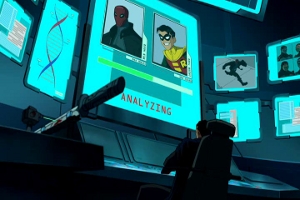
These direct-to-DVD superhero movies are terminally afraid of comic book continuity. That’s why so many have been origin stories like Green Lantern: First Flight, or self-contained mini-series like Justice League: New Frontier. The last time DC tried to animate a mainstream comic book story arc, they gave us the miserable failure Superman: Doomsday…partially directed by Red Hood’s Brandon Vietti.
Credit where credit’s due, Under the Red Hood‘s not that bad. Some evocative moments are scattered throughout. Like Batman’s first meeting with his “new” foe: a elaborate chase scene through the streets of Gotham, culminating at the unnamed industrial plant we might as well call Axis Chemicals. Standing amidst the open vats of corrosive stew, we see Batman recognize the place by flashing back to the the last time he encountered a Red Hood in this building…That Fateful Night when the Joker was “born,” no matter what he says about his horrible childhood.
The new Red Hood calls it the site of “maybe” Batman’s greatest mistake. He tacks a “maybe” on there because he’s an arrogant prick, just like he was in his youth. Wisely, the film doesn’t waste time making the Red Hood’s identity a secret. He calls Batman “Bruce” and once Batman secures a blood sample that’s all she wrote. We can get to what I liked best about the film: its brief flashes of Jason’s career as Robin.
If this film were honestly The Death and Life of Jason Todd, it would’ve begun here and at least taken a stab at answering that “Why?” I asked a few hundred words and about twenty years ago. What the hell’s so special about Jason Todd? I know it’s because they met in Crime Alley, the site of Thomas and Martha Wayne’s fatal shooting All Those Years Ago…but the non-comic book reader has no idea who the hell this kid is…or was, when he worked as Robin…hell, they’re probably still scratching their heads over the whole Nightwing thing. Which is probably why Nightwing sustains a debilitating leg injury halfway through, excusing him from the rest of the film.
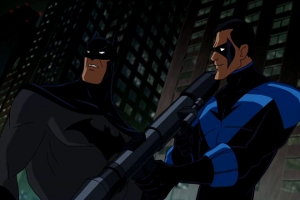
Hell, even before that, Nightwing acts as little more than the exposition initiator, a role he’s sadly fallen into as he’s gotten older and become the Chatty Kathy of the Bat-family. He explains action whenever writers believe they’re writing for morons. Nightwing even comments on this, saying it’s “part of his charm.” No, Dick: it really isn’t. I don’t find being intellectually insulted “charming.” (For example: I’ve watched action films and am fully aware of what Plastique looks like.) What’s “charming” at fourteen can be grating and incongruous when you’re perma-twenty-five, like the rest of your superhero generation. Honestly, if you want to see Dr. Horrible in a good superhero cartoon movie, where he has something to do in the third act, watch him play Flash in New Frontier.
Red Hood gives us our Ghost Ship Moment about thirty minutes in and, after a nine minute fight with some random assassins the screenwriter dreamed up so they wouldn’t have to secure the rights to recognizable villains, we get the Red Hood’s thesis statement. “You can’t stop crime,” he tells Batman. “That’s what you never understood!” The Red Hood hopes to control crime (or, at the very least, Gotham’s organized rackets) by dethroning Black Mask. This would do nothing to curb the excesses of so-called “super criminals” like Joker, Poison Ivy, or Mr. Freeze, but at least you’d know who the corner drug pushers worked for…right, Batman?
Right. Twenty minutes of faffing about later, Jason tells Batman, “I’m what this city needs!” in that entitled, angry tone I imagine all Rob Liefeld’s characters use. And that’s my big problem with the resurrected Jason Todd. Everything about him – from reliance on guns and knives to his boring, tactical assault squad costume – screams 1993. He’s a throwback to a “darker” “grittier” age, when everything struggled to be “darker” or “grittier,” and wound up being stupid. Winick himself is one of those writers who calls his own work “edgy.” Fear those writers, even more than the continuity buffs, for they gave us Image Comics and all that implies.
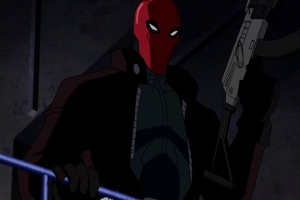
In order to be “edgy” within the confines of the superhero genre, writers inevitably end up presenting heroes with moral false choices. Like the one Jason sets up by the end of the film, eventually kidnapping (and torturing) the Joker. “I don’t know what clouds your judgment worse,” he tells Batman at gunpoint, “your guilt, or your antiquated sense of morality. Bruce, I forgive you for not saving me. But why on God’s green Earth is he still alive?” Because he wants you to kill him, dumbass. Far as he’s concerned, that’s as good as if he killed you himself. Joker doesn’t just kill people…I mean, he will…but any hack with a gun can do that! Joker’s a flaming narcissist, in love with his own special perspective on life so, given the choice, he’ll always go after the idea of a rational and (more importantly) humane order at work in the world. He’s trying to kill that, on general principle, in the same sense that Batman’s trying to “stop crime.” Both are the unreachable goals of idealistic, mad bastards, both of whom recognize (in their clearer moments) that the best than can do is steadily pave a road of little victories behind themselves. That’s why Bats targets corner pushers and local kingpins with equal focus. It’s why Joker targeted you in the first place, Jason. Your death was mean to convince Batman that no one is safe, ever…not even the people Batman personally trained to defend themselves. It’s also why Joker betrays Black Mask as soon as possible (spoiler alert…though, if you know the Joker at all, it really isn’t). Professionals don’t pull crap like that until the Third Act, but Joker can’t pass up a good gag. And to him, the best gags are the ones that hurt the most, for the longest.
So whenever the Joker’s pleased, you should be worried. By the end of this flick, Joker can say, in all honesty, “I’m the only one who’s going to get what he wants!” and I’m terrified, because he’s right. Here we have Batman’s legacy is permanently tainted thanks to Jason’s impressive body count. If he’d died at fifteen in some anonymous argument over some corner, he certainly would’ve murdered all those people. But you just had to give him all that ninja training, didn’t you, Bruce? Then Ra’s al Ghul had to steal his body and dunk him in a Lazarus Pit.
The final effect of Jason’s resurrection is it allows writers to pile more guilt onto Batman. Why would one want to do this? Well…I have no earthly idea. I think it’s because Winick worked under the assumption that hurting Batman automatically makes his stories more interesting. This is false because, for the love of Rao, we’re talkin’ Batman here. Any given night he’s as likely to be chasing down stick-up artists as helping the Justice League avert the next Near-Apocalypse. More the point, we know how Batman responds to guilt: he puts on his costume, goes outside, and fights crime. Even when people don’t come back from the dead.
Still, there are some good lines here (mostly given to John Di Maggio, who obviously loved the hell out of this job), and Bruce Greenwood has a better Bat-voice than William Baldwin or Jeremy Sisto. Brandon Vietti’s a wonderful action director, easily on par with Sam Liu when it comes to a kung fu fight scene…though I noticed the Climactic Battle between Batman and Jason temporarily shifted into the Matrix…

But I’m sure that was just a coincidence. Right, Vietti?
In the end, Batman tells Alfred, “This doesn’t change anything.” And that’s the other Big Problem I have with all this. Like The Dark Knight, Under the Red Hood wants to ask how far Batman will go in the face of a crisis that forces him to compromise his principles. Once again, Batman answers with an elaborate fist fight and a well-thrown batarang, the solution to 85.59% of his problems. It’s predictable and ultimately underwhelming. The shock value of Jason’s resurrection wears off once we realize they really are going to do the same Bat-dance all over again. Anyone who’s read a comic book before knows this’ll go one of two ways: either Jason will reform and rejoin the heroic ranks or he’ll get the kind of ambivalent non-death reserved for reoccurring villains everywhere. Go ahead, guess which happens. I won’t spoil it for you.
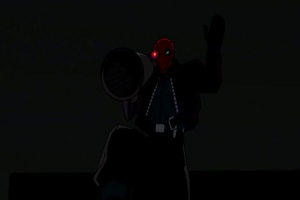
Hopefully this review will still manage to spoil the movie, or at least demonstrate why it was the wrong story to adapt. I know why they did it: Jason Todd’s return to life caused massive spasms in Bat-fandom. Interest ran unbelievably high and sales figures adjusted to compensate. That doesn’t mean this was a story that needed to be told in its own seventy-five minute film. To my mind, one could only justify this as the third act of a very depressing trilogy, with “Another Kid in Crime Alley” filling A New Hope‘s role and “Death in the Family” functioning as The Empire Strikes Back. Without them, Under the Red Hood feels like what it is: the rushed, hasty transcription of a long-running comic book story that isn’t even close to done.
This film frustrated me more than anything. Major Bat-franchise characters have walk-on roles that end up being completely pointless. Our new villain is the same kind of murderous anti-hero Batman’s faced down so often in his long career. Be grateful you came back to life when you did, Todd! Back in 1993, the line snaked all the way around the block. This is supposed to be Batman’s own Magnum Force but it can’t even approach that level of insight. Who cares about the debate over lethal tactics as applied to masked vigilantism in the DC Universe? Batman sure as hell doesn’t. For him, the issue’s long-settled. For me as well.
![]()
![]()
And where the fuck is Tim Drake, anyway? He was the Robin I always identified with, and isn’t that the whole point? It was easy because, in a room full of Bruce Waynes, Dick Graysons, Barbara Gordons, and Alfreds, Tim wound up looking like the “normal” one (green, Kevlar-reinforced tights notwithstanding). He was a fine, upstanding computer nerd who figured out Batman’s secret identity all on his own through the power of (gasp, shock) detective work. Plus, much like most of his readers (including Your Humble Narrator), Tim had a living parental unit – whom he actually spoke to on occasion! Along with something dangerously close to a social life. We even got crazy girlfriends at around the same time…both of them blondes!


“Agree agree agree” comments are boring but affirming, and that’s all I can offer. I will say this: I watched this without having noticed they brought Jason Todd back in the comics (I’m more of a fellow traveler than a real comic book fan) and so I was surprised by the his reappearance, but only slightly. Seems like they’ve wasted an awful lot of (what’s the word I’m looking for? Seriousness? Impact?) for a chance to get a bump in sales and a return to the bad old 90s. Also, you know what’s gritty? Carrying an AK-47. Yep. Nothing grittier than that.
And, really, Bender as The Joker?
Get Tim Curry, dammit!
Professor: Affirmation is never boring. And I believe the word your looking for is “AAAAAAAAAGGGGGGHHHHHHH!”
Actually, this is all just a bad dream. Jason Todd’s still dead and under glass…at least in my heart. I think the real word your looking for is “verisimilitude.” Every sane observer of the Bat-family knows bringing a little kid to a shootout is asking for trouble. No matter how ell you train ’em, sooner or later, somebody’s gonna get lucky and you’re gonna wind up with a sidekick who’s either dead or (as Green Arrow found out in the 70s) into some righteously heavy drugs. Jason’s was a cautionary tale that can never be told again with any comparable amount of impact. Besides, now that everyone’s died and come back to life again at least once, we’re pretty hip to the scam by now.
Filip: Meh. Curry’s never really nailed an American accent I could stand for any length of time. He’s got the Evil Laugh for it, though. I’ll happily give him that. Bender didn’t do so badly, as these things go. Better than Kevin Michael Richardson, though I know that’s not saying much. My problem being Joker had so little to do.
Verisimilitude was part of it, but I think it humanized Batman a bit by having him have made an actual mistake that he could brood over on long winter nights. Solemnity? I still can’t quite put my finger on it…but it’s gone now never to return.
Kinda like how Cap used to have his fall back of guilt for Bucky’s death, you know, back before they decided he couldn’t remain dead either.
I think the reason Jason’s death hurt him was because he was effectively Jason’s parental figure; the job of a parent is to protect their child and make them ready for the world. Bruce failed in that endeavor, and that’s why Jason’s death hurts him harder. This was someone he was directly responsible for training, and failed miserably.
Damian Wayne is somewhat interesting in that while he’s a self centered little turd, it’s easy to see why he turned out that way. He was raised from birth to believe that he was the heir to a powerful criminal empire, and when that wasn’t happening, he was being trained in how to kill people from birth.
As much as I dislike Disney tvshows they can occasionally do something genuinely good. One of the Aladdin villains Mozenrath is an asshole but considering that a.) the man who raised him was so ruthless that even Jafar was afraid of him and b.) that the source of his magical powers is slowly killing him and you can see why he’s a villain.